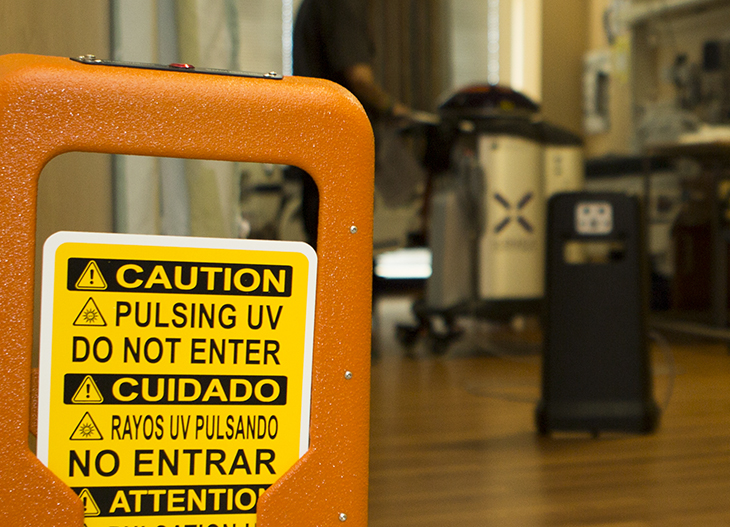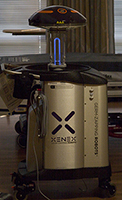The Milwaukee VA Medical Center has a new weapon against invisible critters that can spread infection, illness or even death – a purple and silver robot about the size of a trash can that looks like R2D2 and obliterates the buggers with 67 pulses of ultraviolet light per second.
Meet Xena and Thor – two germ-zapping robots added to Milwaukee’s cleaning and infection control procedures to ensure better health and safety for Veterans and employees.
VA put the machines into action at the end of June after holding a “name the robots” contest among employees. Milwaukee is the first VA hospital in this region to use the robots. The portable devices, manufactured by Xenex, are the only mercury-free systems available and kill numerous micro-organisms in about 15 minutes.
“This basically takes cleaning to the next level,” said Jai Reneau, Environmental Management Services division manager. “We already do a good job of cleaning, but even with the best cleaning there will always be germs that can’t be seen by the naked eye. We chose this system because it doesn’t introduce unnecessary hazardous chemicals to the hospital, and it has a very good success rate.”
Typically, after a room is manually cleaned by human hands, the robots take over. Housekeepers wheel it into position, put up orange safety cones, press a button then leave the room. The robot head rises in the air, then attacks the room with bright pulses of UV-C light. The machines are safe for humans, but you can’t look directly at the light.

Gaylyn Raduenz, infection preventionist at the Milwaukee VA Medical Center, explains to CBS-58 how the Xenex robot destroys invisible germs and creates a safer environment for patients and employees.
The light isn’t the same as a tanning bed. Instead of giving bacteria a suntan, it scrambles their DNA.
“It actually exerts enough pressure to open the bacterial cell wall, scrambles the DNA and makes the bacteria inert,” said Gaylyn Raduenz, a registered nurse and infection preventionist. “Then the bacteria can’t reproduce and it can’t infect someone.”
Studies show the treatment lowers infection rates 20 to 50 percent, but Milwaukee officials won’t know local results for about six months.
The robots will mostly be used in the Spinal Cord Injury Center, Community Living Center and other hospital areas where there is a higher risk of infection because of the type of care provided.
Raduenz said hospital infection rates are already lower than national benchmarks, but this takes safety a step further.
Each machine costs about $92,000, and Raduenz said it’s money well spent.
“You can’t put a price on the health and well-being of our Veterans,” Raduenz said. “Our Veterans deserve the absolute best we can provide. That’s priceless.”

Topics in this story
More Stories
The Medical Foster Home program offers Veterans an alternative to nursing homes.
Watch the Under Secretary for Health and a panel of experts discuss VA Health Connect tele-emergency care.
The 2024 National Veteran Suicide Prevention Annual Report provides the foundation for VA’s suicide prevention programs and initiatives.







